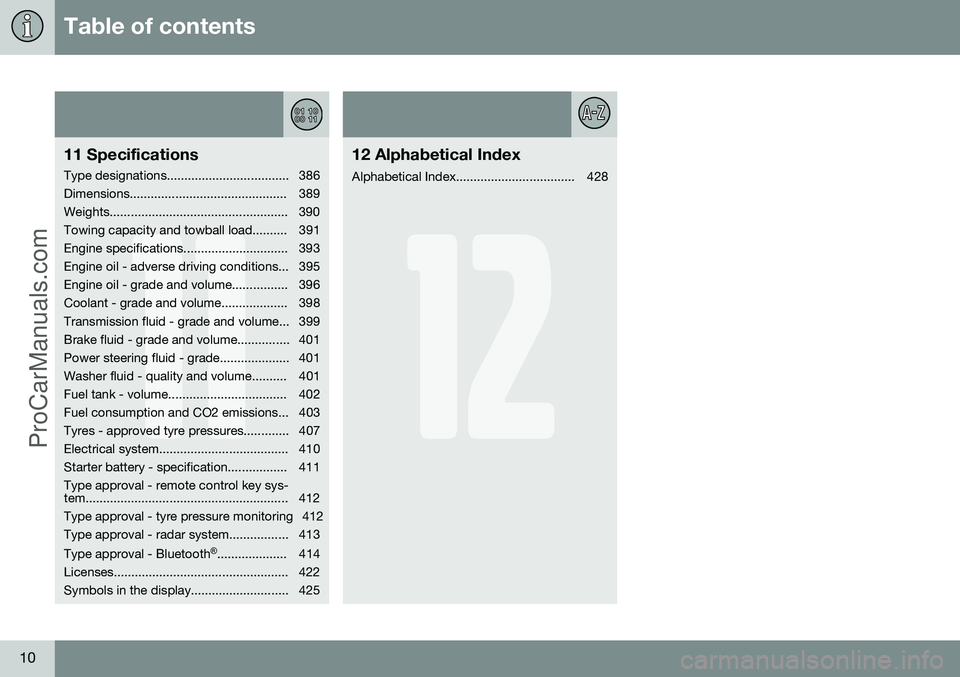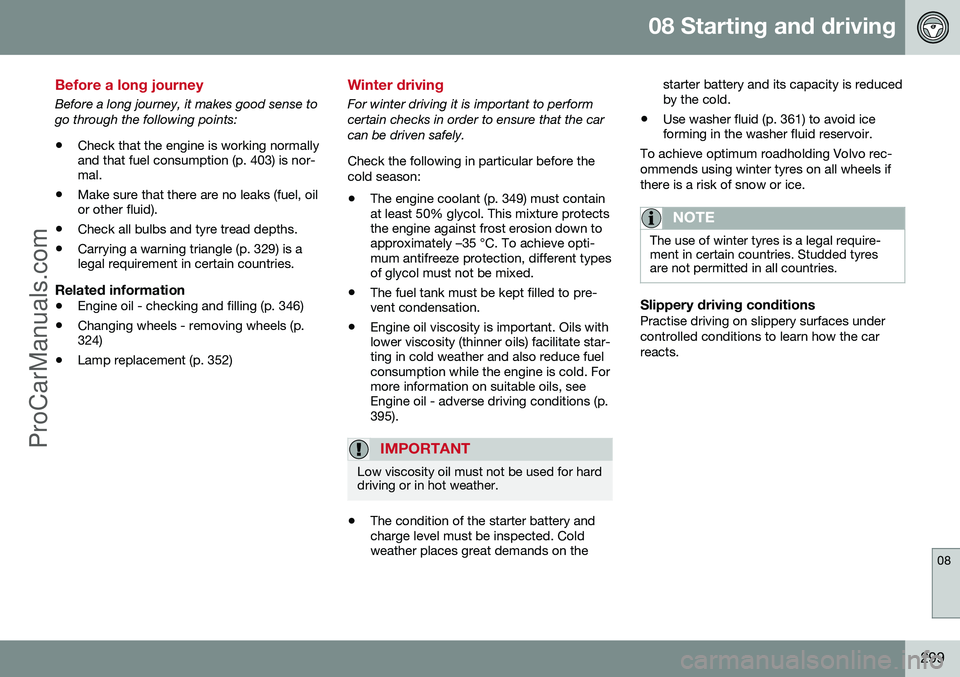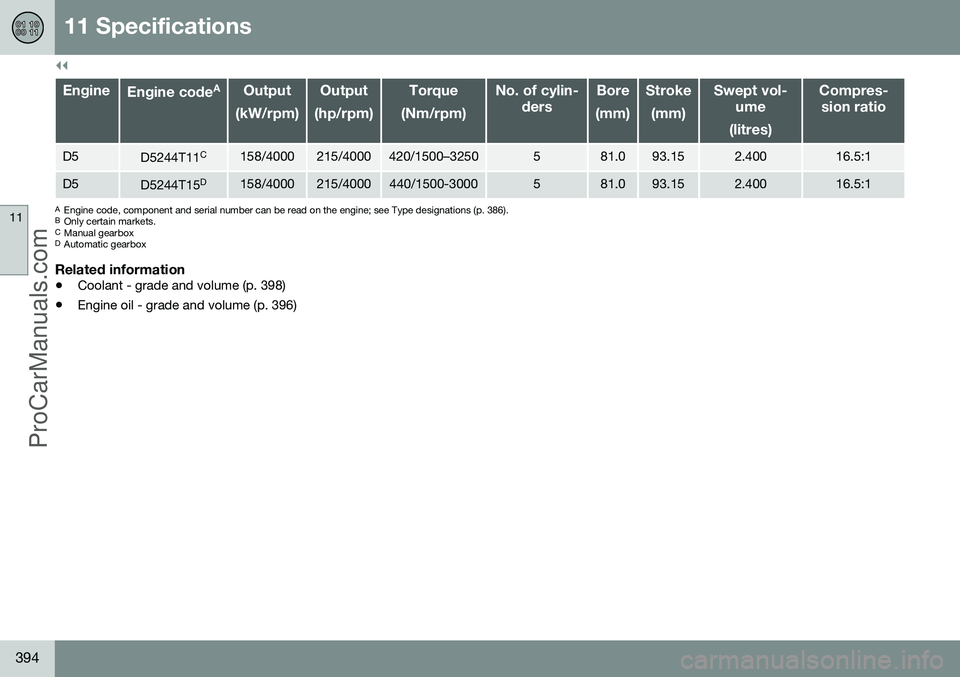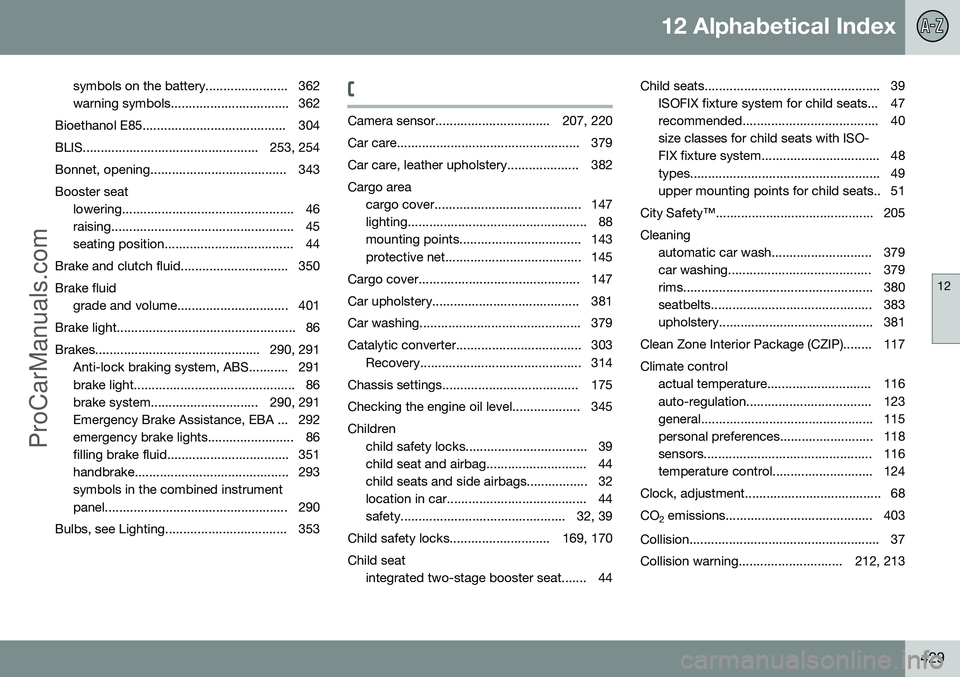oil type VOLVO V60 2014 Owners Manual
[x] Cancel search | Manufacturer: VOLVO, Model Year: 2014, Model line: V60, Model: VOLVO V60 2014Pages: 442, PDF Size: 13.85 MB
Page 12 of 442

Table of contents
10
11
11 Specifications
Type designations................................... 386
Dimensions............................................. 389
Weights................................................... 390
Towing capacity and towball load.......... 391
Engine specifications.............................. 393
Engine oil - adverse driving conditions... 395
Engine oil - grade and volume................ 396
Coolant - grade and volume................... 398
Transmission fluid - grade and volume... 399
Brake fluid - grade and volume............... 401
Power steering fluid - grade.................... 401
Washer fluid - quality and volume.......... 401
Fuel tank - volume.................................. 402
Fuel consumption and CO2 emissions... 403
Tyres - approved tyre pressures............. 407
Electrical system..................................... 410
Starter battery - specification................. 411Type approval - remote control key sys-
tem.......................................................... 412
Type approval - tyre pressure monitoring 412
Type approval - radar system................. 413 Type approval - Bluetooth®
.................... 414
Licenses.................................................. 422
Symbols in the display............................ 425
12
12 Alphabetical Index
Alphabetical Index.................................. 428
ProCarManuals.co’
Page 22 of 442

||
01 Introduction
01
20* Option/accessory, for more information, see Introduction.
A sophisticated air quality system, IAQS* (Interior Air Quality System) ensures that theincoming air is cleaner than the air in the traf-fic outside. The system consists of an electronic sensor and a carbon filter. The incoming air is moni-tored continuously and if there is an increasein the level of certain unhealthy gases such ascarbon monoxide then the air intake isclosed. Such a situation may arise in heavytraffic, queues and tunnels for example. The entry of nitrous oxides, ground-level ozone and hydrocarbons is prevented by thecarbon filter.
InteriorThe interior of a Volvo is designed to be plea-sant and comfortable, even for people withcontact allergies and for asthma sufferers.Extreme attention has been given to choosingenvironmentally-compatible materials.
Volvo workshops and the environmentRegular maintenance creates the conditionsfor a long service life and low fuel consump-tion for your car. In this way you contribute toa cleaner environment. When Volvo's work-shops are entrusted with the service andmaintenance of your car it becomes part ofour system. Volvo makes clear demandsregarding the way in which our workshopsare designed in order to prevent spills anddischarges into the environment. Our work-shop staff have the knowledge and the tools required to guarantee good environmentalcare.
Reducing environmental impactYou can easily help reduce environmentalimpact - here are a few tips: •
Avoid letting the engine idle - switch off the engine when stationary for longerperiods. Pay attention to local regula-tions.
• Drive economically - think ahead.
• Perform service and maintenance inaccordance with the owner's manual'sinstructions - follow the intervals recom-mended in the Service and WarrantyBooklet.
• If the car is equipped with an engineblock heater*, use it before starting fromcold - it improves starting capacity andreduces wear in cold weather and theengine reaches normal operating tem-perature more quickly, which lowers con-sumption and reduces emissions.
• High speed increases consumption con-siderably due to increased wind resis-tance - a doubling of speed increaseswind resistance 4 times.
• Always dispose of environmentally hazar-dous waste, such as batteries and oils, inan environmentally safe manner. Consulta workshop in the event of uncertaintyabout how this type of waste should bediscarded - an authorised Volvo work-shop is recommended. Following this advice can save money, the planet's resources are saved, and the car'sdurability is extended. For more informationand further advice, see Eco guide (p. 63),Economical driving (p. 305) and Fuel con-sumption (p. 403).
RecyclingAs a part of Volvo's environmental work, it isimportant that the car is recycled in an envi-ronmentally sound manner. Almost all of thecar can be recycled. The last owner of the caris therefore requested to contact a dealer forreferral to a certified/approved recyclingfacility.
Related information
•
The owner's manual and the environment (p. 21)
ProCarManuals.co’
Page 301 of 442

08 Starting and driving
08
299
Before a long journey
Before a long journey, it makes good sense to go through the following points: •Check that the engine is working normally and that fuel consumption (p. 403) is nor-mal.
• Make sure that there are no leaks (fuel, oilor other fluid).
• Check all bulbs and tyre tread depths.
• Carrying a warning triangle (p. 329) is alegal requirement in certain countries.
Related information
• Engine oil - checking and filling (p. 346)
• Changing wheels - removing wheels (p.324)
• Lamp replacement (p. 352)
Winter driving
For winter driving it is important to perform certain checks in order to ensure that the carcan be driven safely. Check the following in particular before the cold season:
• The engine coolant (p. 349) must contain at least 50% glycol. This mixture protectsthe engine against frost erosion down toapproximately –35 °C. To achieve opti-mum antifreeze protection, different typesof glycol must not be mixed.
• The fuel tank must be kept filled to pre-vent condensation.
• Engine oil viscosity is important. Oils withlower viscosity (thinner oils) facilitate star-ting in cold weather and also reduce fuelconsumption while the engine is cold. Formore information on suitable oils, seeEngine oil - adverse driving conditions (p.395).
IMPORTANT
Low viscosity oil must not be used for hard driving or in hot weather.
•The condition of the starter battery and charge level must be inspected. Coldweather places great demands on the starter battery and its capacity is reducedby the cold.
• Use washer fluid (p. 361) to avoid iceforming in the washer fluid reservoir.
To achieve optimum roadholding Volvo rec- ommends using winter tyres on all wheels ifthere is a risk of snow or ice.
NOTE
The use of winter tyres is a legal require- ment in certain countries. Studded tyresare not permitted in all countries.
Slippery driving conditionsPractise driving on slippery surfaces under controlled conditions to learn how the carreacts.
ProCarManuals.co’
Page 304 of 442

08 Starting and driving
08
302
Fuel - petrol
Petrol is used as fuel. Petrol must fulfil the EN 228 standard. Most engines can be run with octane ratings of 95and 98 RON. Only in exceptional casesshould 91 RON be used.
• 95 RON can be used for normal driving.
• 98 RON is recommended for optimum performance and minimum fuel consump-tion.
When driving in temperatures above +38 °C, fuel with the highest possible octane rating isrecommended for optimum performance andfuel economy.
IMPORTANT
• Always refuel with unleaded petrol so as not to damage the catalytic con-verter.
• Do not use additives not recom-mended by Volvo.
Related information
•
Fuel - handling (p. 301)
• Economical driving (p. 305)
• Fuel consumption and CO2 emissions (p. 403)
• Fuel tank - volume (p. 402)
Fuel - diesel
Diesel is used as fuel. Only use diesel fuel from well-known produc- ers. Never use diesel of dubious quality. Die-sel should fulfil the EN 590 or JIS K2204standards. Diesel engines are sensitive tocontaminants in the fuel, such as excessivelyhigh volumes of sulphur particles for exam-ple. At low temperatures (-6 °C to -40 °C), a par- affin precipitate may form in the diesel fuel,which may lead to ignition problems. Specialdiesel fuel designed for low temperaturesaround freezing point is available from themajor oil companies. This fuel is less viscousat low temperatures and reduces the risk ofparaffin precipitate. The risk of condensation in the fuel tank is reduced if the tank is kept well filled. Whenrefuelling, check that the area around the fuelfiller pipe is clean. Avoid spilling fuel onto thepaintwork. Wash off any spillage with deter-gent and water.
IMPORTANT
Only ever use fuel that fulfils the European diesel standard. The sulphur content must be a maximum of 50 ppm.
IMPORTANT
Diesel type fuels that must not be used:
• Special additives
• Marine diesel fuel
• Heating oil
• FAME 15
(Fatty Acid Methyl Ester) and
vegetable oil.
These fuels do not fulfil the requirements in accordance with Volvo recommendationsand generate increased wear and enginedamage that is not covered by the Volvowarranty.
Empty tankThe design of the fuel system in a diesel engine means that if the vehicle runs out offuel, the tank may need to be vented in theworkshop in order to restart the engine afterfuelling. Once the engine has stopped due to fuel starvation, the fuel system needs a fewmoments to carry out a check. Do this beforestarting the engine, once the fuel tank hasbeen filled with diesel:
1. Insert the remote control key in the igni- tion switch and push it in to the end posi-
15Diesel fuel may contain a certain amount of FAME, but further amounts must not be added.
ProCarManuals.co’
Page 390 of 442

||
11 Specifications
11
388
approval number. The label is visible when the right rear door is opened.
Label for parking heater.
Engine code and engine serial number.
Label for engine oil.
Gearbox type designation and serial num- ber.
Manual gearbox
Automatic gearbox
Car's identification number. (VIN Vehicle Identification Number)
Further information on the car is presented inthe registration document.
NOTE
It is not intended that the decals illustrated in the owner's manual should be exactreplicas of those in the car. They areincluded to show their approximateappearance and location in the car. Theinformation that applies to your particularcar is available on the respective decalsfor your car.
Related information
• Weights (p. 390)
• Engine specifications (p. 393)
ProCarManuals.co’
Page 396 of 442

||
11 Specifications
11
394
EngineEngine codeAOutput
(kW/rpm)Output
(hp/rpm)Torque
(Nm/rpm)No. of cylin- dersBore
(mm)Stroke (mm)Swept vol- ume
(litres)Compres- sion ratio
D5D5244T11 C158/4000215/4000420/1500–3250581.093.152.40016.5:1
D5D5244T15D158/4000215/4000440/1500-3000581.093.152.40016.5:1
A
Engine code, component and serial number can be read on the engine; see Type designations (p. 386).
B Only certain markets.
C Manual gearbox
D Automatic gearbox
Related information
• Coolant - grade and volume (p. 398)
• Engine oil - grade and volume (p. 396)
ProCarManuals.co’
Page 399 of 442

11 Specifications
11
397
EngineEngine codeAOil gradeVolume, incl. oil filter
(litres)
T3B4164T3Certified and factory-filled oil: Oil grade WSS-M2C925-A
options for service: Oil grade: ACEA A5/B5 Viscosity: SAE 5W–30approx. 4.1
T4B4164Tapprox. 4.1
T4FB4164T2approx. 4.1
T4 DB5204T8Oil grade: ACEA A5/B5 Viscosity: SAE 0W–30approx 5.5
T5
DB5204T9approx 5.5
T5B4204T11Castrol Edge Professional V 0W-20 or 0w20 VCC RBS0-2AEapprox. 5.4
T6B4204T9approx. 5.4
D4D4204T5approx. 5.6
A
Engine code, component and serial number can be read on the engine; see Type designations (p. 386).
B Manual gearbox
C Automatic gearbox
D Only certain markets.
Related information
• Engine oil - adverse driving conditions (p. 395)
• Engine oil - checking and filling (p. 346)
ProCarManuals.co’
Page 402 of 442

||
11 Specifications
11
400
NOTE
Under normal driving conditions, the gear- box oil does not need to be changed dur-ing its service life. However, it may be nec-essary under adverse driving conditions.
Related information
•Engine oil - adverse driving conditions (p. 395)
• Type designations (p. 386)
ProCarManuals.co’
Page 431 of 442

12 Alphabetical Index
12
429
symbols on the battery....................... 362
warning symbols................................. 362
Bioethanol E85........................................ 304
BLIS................................................. 253, 254
Bonnet, opening...................................... 343Booster seat lowering................................................ 46
raising................................................... 45
seating position.................................... 44
Brake and clutch fluid.............................. 350 Brake fluid grade and volume............................... 401
Brake light.................................................. 86
Brakes.............................................. 290, 291 Anti-lock braking system, ABS........... 291
brake light............................................. 86
brake system.............................. 290, 291
Emergency Brake Assistance, EBA ... 292
emergency brake lights........................ 86
filling brake fluid.................................. 351
handbrake........................................... 293symbols in the combined instrument
panel................................................... 290
Bulbs, see Lighting.................................. 353
C
Camera sensor................................ 207, 220
Car care................................................... 379
Car care, leather upholstery.................... 382Cargo area cargo cover......................................... 147
lighting.................................................. 88
mounting points.................................. 143
protective net...................................... 145
Cargo cover............................................. 147
Car upholstery......................................... 381
Car washing............................................. 379
Catalytic converter................................... 303 Recovery............................................. 314
Chassis settings...................................... 175
Checking the engine oil level................... 345Children child safety locks.................................. 39
child seat and airbag............................ 44
child seats and side airbags................. 32
location in car....................................... 44
safety.............................................. 32, 39
Child safety locks............................ 169, 170 Child seat integrated two-stage booster seat....... 44 Child seats................................................. 39
ISOFIX fixture system for child seats... 47
recommended...................................... 40size classes for child seats with ISO-
FIX fixture system................................. 48
types..................................................... 49
upper mounting points for child seats.. 51
City Safety™............................................ 205 Cleaning automatic car wash............................ 379
car washing........................................ 379
rims..................................................... 380
seatbelts............................................. 383
upholstery........................................... 381
Clean Zone Interior Package (CZIP)........ 117 Climate control actual temperature............................. 116
auto-regulation................................... 123
general................................................ 115
personal preferences.......................... 118
sensors............................................... 116
temperature control............................ 124
Clock, adjustment...................................... 68 CO 2 emissions......................................... 403
Collision..................................................... 37
Collision warning............................. 212, 213
ProCarManuals.co’
Page 439 of 442

12 Alphabetical Index
12
437
Towbar
detachable, attachment...................... 310
detachable, removal........................... 311
Towbar, see Towing equipment.............. 309 Towbar - detachable attachment/removal.................... 310, 311
Towing..................................................... 313 towing eye.......................................... 315
Towing bracket........................................ 309 specifications...................................... 309
Towing capacity and towball load........... 391
Towing eye.............................................. 315
TPMS - Tyre Pressure Monitoring........... 330
Traction control........................................ 175
Trailer....................................................... 306 cable........................................... 306, 307
driving with a trailer............................ 306
snaking............................................... 312
Trailer stability assist............................... 176
Trailer Stability Assist.............................. 312
Transmission............................................ 271Transmission oil volume and grade............................... 399
Transponder.............................................. 17
Tread depth............................................. 321
Tread wear indicators.............................. 320 Trip computer.......... 104, 105, 109, 112, 113
Trip meter.................................................. 68
Trip meter, resetting................ 107, 110, 112Troubleshooting
Adaptive Cruise Control..................... 199
TSA - trailer stability assist ............. 176, 312
Tunnel console........................................ 139 12 V socket......................................... 141
cigarette lighter and ashtray............... 139
Tunnel detection........................................ 81 Type approval Bluetooth ®
.......................................... 414
radar system....................................... 413
remote control key system................. 412
tyre pressure monitoring..................... 412
Type designations................................... 386
Tyre dimension........................................ 322
Tyre load index........................................ 323
Tyre pressure label.................................. 328
Tyre pressure monitoring......................... 330 Adjust.................................................. 330
arming................................................. 331
deactivate........................................... 331
driveable punctured tyres (SST)......... 332
low tyre pressure................................ 331
recommendations............................... 332 Tyres
direction of rotation............................ 318
maintenance....................................... 318
pressure...................................... 328, 407
puncture repair................................... 333
specifications...................................... 407
tread depth......................................... 321
tread wear indicators.......................... 320
tyre pressure monitoring..................... 330
winter tyres......................................... 321
U
Unlockingfrom the inside.................................... 165
from the outside................................. 164
Unlocking with the key blade................... 162
V
Vanity mirror...................................... 88, 140
Ventilation................................................ 119
Vibration damper..................................... 309
Volvo Sensus............................................. 68
ProCarManuals.co’